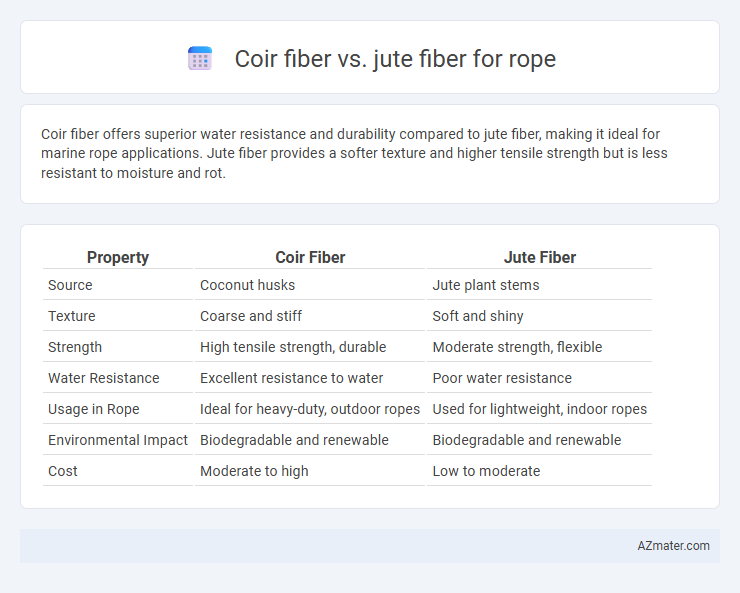Coir fiber offers superior water resistance and durability compared to jute fiber, making it ideal for marine rope applications. Jute fiber provides a softer texture and higher tensile strength but is less resistant to moisture and rot.
Table of Comparison
| Property | Coir Fiber | Jute Fiber |
|---|---|---|
| Source | Coconut husks | Jute plant stems |
| Texture | Coarse and stiff | Soft and shiny |
| Strength | High tensile strength, durable | Moderate strength, flexible |
| Water Resistance | Excellent resistance to water | Poor water resistance |
| Usage in Rope | Ideal for heavy-duty, outdoor ropes | Used for lightweight, indoor ropes |
| Environmental Impact | Biodegradable and renewable | Biodegradable and renewable |
| Cost | Moderate to high | Low to moderate |
Introduction to Coir Fiber and Jute Fiber
Coir fiber, derived from the outer husk of coconut, offers exceptional durability, water resistance, and natural elasticity, making it ideal for rope production in marine and outdoor applications. Jute fiber, extracted from the stem of the jute plant, is valued for its strength, biodegradability, and softness, commonly used in lightweight ropes and sacks. Both fibers provide eco-friendly alternatives to synthetic ropes, with coir excelling in moisture-rich environments and jute favored for its cost-effectiveness and easy processing.
Botanical Origins and Availability
Coir fiber, derived from the outer husk of the coconut (Cocos nucifera), is abundant in tropical regions like India, Sri Lanka, and the Philippines, making it highly available for rope manufacturing. Jute fiber originates from the stem of the Corchorus plant, primarily Corchorus olitorius and Corchorus capsularis, cultivated extensively in Bangladesh and India, contributing to its widespread availability. Both fibers' botanical origins influence their texture and strength, with coir being coarser and more water-resistant, while jute offers softness and flexibility in rope applications.
Physical Characteristics and Structure
Coir fiber, derived from coconut husks, is coarser and has a higher lignin content, providing greater rigidity and water resistance compared to jute fiber. Jute fiber is softer, more flexible, and has a smooth surface due to lower lignin and higher cellulose, making it easier to spin into finer ropes. The coarse, hollow structure of coir enhances durability and abrasion resistance, while jute's dense, tubular structure offers better tensile strength but less resistance to moisture.
Strength and Durability Comparison
Coir fiber exhibits higher tensile strength and excellent resistance to saltwater, making it ideal for marine rope applications, whereas jute fiber offers moderate strength but tends to degrade faster under moisture exposure. Coir's natural durability and abrasion resistance outperform jute, resulting in longer-lasting rope products in harsh environmental conditions. Jute fiber ropes, conversely, are more biodegradable and suitable for lightweight, temporary uses but lack the robust endurance of coir-based ropes.
Water Resistance and Weather Tolerance
Coir fiber offers superior water resistance and durability compared to jute fiber, making it ideal for ropes exposed to wet and marine environments. Jute fiber tends to absorb moisture quickly, leading to faster degradation and reduced weather tolerance. Coir's natural resilience to saltwater and high humidity enhances its longevity in outdoor applications.
Environmental Impact and Sustainability
Coir fiber, derived from coconut husks, offers superior durability and natural resistance to saltwater, making it an eco-friendly choice for marine ropes, while jute fiber, sourced from the jute plant, boasts rapid renewability and biodegradability, contributing to lower environmental footprints. Both fibers are biodegradable and renewable, but coir's resistance to microbial decay extends rope lifespan, reducing frequent replacements and waste. The cultivation of jute requires fewer pesticides and less water compared to conventional crops, enhancing its sustainability profile in rope manufacturing.
Rope Making Process: Coir vs Jute
Coir fiber, derived from coconut husks, undergoes a more labor-intensive rope making process involving retting, drying, and fiber extraction, resulting in coarse, durable ropes ideal for heavy-duty applications. Jute fiber, sourced from the jute plant, follows a simpler retting and stripping process, producing softer, flexible ropes preferred for packaging and decorative purposes. The choice between coir and jute fibers depends on the desired rope strength, texture, and environmental resistance, with coir offering greater durability and water resistance compared to jute.
Common Applications of Coir and Jute Ropes
Coir fiber ropes are widely used in marine applications, gardening, and erosion control due to their high water resistance and durability. Jute fiber ropes are preferred for packaging, agricultural bundling, and decorative crafts because of their softness and ease of dyeing. Both coir and jute ropes find applications in eco-friendly products, but coir excels in outdoor, moisture-prone environments while jute suits indoor and lightweight uses.
Cost Analysis and Market Trends
Coir fiber offers a cost-effective alternative to jute fiber for rope manufacturing, with prices typically lower due to abundant coconut husk availability, resulting in reduced raw material costs. Market trends reveal a growing demand for coir ropes in marine and agricultural sectors due to superior durability and resistance to saltwater, whereas jute ropes maintain popularity for eco-friendly packaging and decorative uses. Ongoing innovations in coir processing technologies further enhance its competitiveness by lowering production costs and expanding its market share globally.
Choosing the Best Fiber for Rope: Key Takeaways
Coir fiber offers superior water resistance and durability, making it ideal for outdoor rope applications exposed to moisture and rough wear. Jute fiber provides greater softness and flexibility, suitable for decorative or light-duty ropes where comfort and appearance matter. Assessing rope use environment and strength requirements ensures choosing between coir's robustness and jute's pliability for optimal rope performance.

Infographic: Coir fiber vs Jute fiber for Rope
 azmater.com
azmater.com